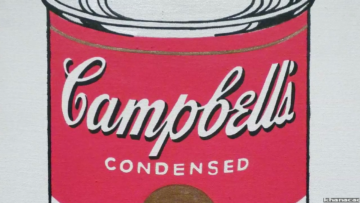

Pop Art looks out into the world. It doesn’t look like a painting of something, it looks like the thing itself. — Artist Roy Lichtenstein
By 2021, most of us accept that Andy Warhol’s Campbell’s Soup Cans are art, but there are some who are still not confident as to why.
No shame in that.
Art Historian Steven Zucker and the Khan Academy’s Sal Khan tackle the question head on in the above video, concluding that the work is not only a reflection of the time in which it was created, but that the enormity of its impact was made possible by that timing.
Forty-five years before Warhol escorted those lowly, instantly recognizable soup cans from the supermarket to the far loftier realm of museum and gallery, the art world was thrown into an uproar over Marcel Duchamp’s provocative readymade, Fountain, a prefabricated urinal submitted to the Society of Independent Artists inaugural exhibition as the work of the fictitious R. Mutt. The Tate Modern’s website summarizes its importance:
Fountain tested beliefs about art and the role of taste in the art world. Interviewed in 1964, Duchamp said he had chosen a urinal in part because he thought it had the least chance of being liked (although many at the time did find it aesthetically pleasing). He continued: ‘I was drawing people’s attention to the fact that art is a mirage. A mirage, exactly like an oasis appears in the desert. It is very beautiful until, of course, you are dying of thirst. But you don’t die in the field of art. The mirage is solid.’
Campbell’s soup cans possess a similar solidity.
The familiar label dates back to 1898 when a Campbell’s exec drew inspiration from Cornell University’s red and white football uniforms.
A full page magazine ad from 1934 introduces Cream of Mushroom and Noodle with Chicken (soon to become Chicken Noodle) by reminding readers to “Look for the Red-and-White Label.”
By 1962, Campbell’s had given consumers their pick of 32 flavors, and Warhol painted all 32 of them. Not the contents. Just those uniform cans.
Los Angeles’ Ferus Gallery sold five of them before gallerist Irving Blum realized that their impact was greatest when all 32 were displayed together, to echo how consumers were used to seeing the real thing.
Warhol had a personal connection to his subject matter, but it wasn’t like he set out to rep a lifelong favorite. Rather, he was following up on a friend’s suggestion to paint something everyone would would recognize, with or without passionate feelings. (He seemed to be without:)
I used to drink it. I used to have the same lunch every day, for 20 years, I guess, the same thing over and over again.
Warhol brought a successful commercial illustrator’s eye to his Campell’s Soup Cans, capitalizing on the public’s existing knowledge. The colors, the custom cursive logo over the sans serif flavor font, and the shape of the cans had couched themselves in the early-60s American consciousness.
As had industrialization as the overarching system by which most lives were ordered. The artist may not have offered overt comment on mass produced items, convenience foods, or brand loyalty. He just depended on the public to be so intimately acquainted with them, they had faded into the wallpaper of their daily lives.
Nor was the public overly accustomed to everyday objects reconceptualized as art. These days, we’re a bit blasé.
Warhol’s subject matter may have been prosaic, but his timing, Khan and Zucker tell us, could not have been better.
As Campbell’s is to soup, Marilyn Monroe is to celebrity — an enduring household name. Her sexy, youthful image is imprinted on fans born decades after her death.
The most universal Marilyn is the one from the Niagara publicity still, immortalized in acrylic and silkscreen in Warhol’s Marilyn Diptych. One of his most defining works, it was produced the same year as his soup cans (and Monroe’s suicide at the age of 36).
In considering this work for his ongoing series, Great Art Explained, gallerist James Payne delves into Warhol’s fascination with multiples, celebrity, religious iconography, machination, and death, noting that “both Warhol and Marilyn understood transformation”:
From early on in his career, Andy Warhol had an extraordinary ability of finding the sacred in the profane…. He was a product of the Eastern European immigrant experience who himself became an icon, a shy, gay, working class man who became the court painter of the 1970s, an artist who embraced consumerism, celebrity and the counterculture and changed modern art in the process.
Related Content:
Andy Warhol Demystified: Four Videos Explain His Groundbreaking Art and Its Cultural Impact
Take a Virtual Tour of the Andy Warhol Exhibition at the Tate Modern
Ayun Halliday is an author, theatermaker, and Chief Primatologist of the East Village Inky zine. Follow her @AyunHalliday
Andy Warhol’s Art Explained: What Makes His Iconic Campbell’s Soup Cans & Marilyn Monroe Diptych Art? is a post from: Open Culture. Follow us on Facebook and Twitter, or get our Daily Email. And don't miss our big collections of Free Online Courses, Free Online Movies, Free eBooks, Free Audio Books, Free Foreign Language Lessons, and MOOCs.


0 Commentaires